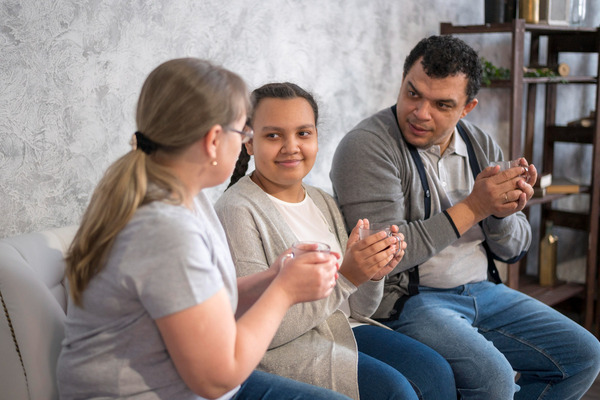How To Talk To Loved Ones About Starting Family Therapy
Family therapy offers a supportive way to work through conflicts, improve communication, and heal disconnects among family members. While the idea of sitting together in a therapist’s office to tackle difficult issues might feel overwhelming, it can lead to meaningful growth and stronger relationships for everyone involved.
The ultimate goal of family therapy is to help families function in a way that allows each person to thrive and feel connected, while also maintaining their own independence and sense of self. This creates a safe environment where relationships can grow and strengthen over time, rather than break down.
Inviting loved ones to begin the journey of family therapy may feel challenging, but it can be a powerful step toward lasting change. Over time, family members often discover new ways to understand each other, resolve conflict, and create a healthier, more connected home life. Investing in this process can help families build a solid foundation for the future.
Disclaimer: This article is for informational purposes only and does not replace professional medical, mental health, or therapeutic advice. Always consult with a qualified healthcare provider or licensed therapist for guidance tailored to your specific situation and needs.

Understanding Family Therapy: How It Helps Families Heal Together
Family therapy is a type of counseling that supports families in working through challenges together rather than focusing on individuals separately. According to the American Association for Marriage and Family Therapy (AAMFT), this approach examines how relationships and behavior patterns within the family affect each member’s well-being.
The aim of family therapy is to explore how interactions between family members may be contributing to larger challenges within the household. Without a neutral third party, families often fall into repetitive patterns that are unproductive and difficult to change. A therapist helps guide these interactions in a more positive and constructive direction.
Having an impartial person in the room allows individuals to express themselves in ways they may not have been able to before. In many sessions, there may be a focus on what’s known as “the identified patient” — often seen as the black sheep or scapegoat. This individual is usually blamed for ongoing tension or disruption within the family.
However, therapy often reveals that the behaviors or symptoms of this person are actually signs of deeper, shared issues. Family therapy encourages all members to reflect on their own actions, take responsibility, and work together to create meaningful, lasting change.
By fostering open communication and shared responsibility, family therapy can help strengthen relationships and build a healthier, more supportive home environment.
Why Family Therapy Can Be Life-Changing
According to the American Association for Marriage and Family Therapy (AAMFT), over 1.8 million people are receiving help from marriage and family therapists at any given time.
An impressive 98% of clients rate their therapy experience as excellent, while 90% report noticeable improvements in their emotional well-being.
Family therapy helps people work through past challenges while creating space for new, healthier patterns moving forward. It offers a chance to rebuild relationships, strengthen communication, and create lasting positive change. When families grow together, healing becomes a shared journey.
Understanding and Breaking the Cycle of Intergenerational Trauma
Intergenerational trauma occurs when the emotional and psychological impact of a traumatic event affects not only the individual who experienced it but also their family members. According to the American Psychological Association, this can lead to relatives displaying similar emotional and behavioral responses—even if they never lived through the original event themselves.
Even when you dislike how certain experiences make you feel, intergenerational trauma can shape your responses in ways you may not fully realize. Often, these learned behaviors are all you know, causing the same harmful patterns to repeat across generations. Recognizing these patterns is a powerful first step toward healing. It opens the door to making intentional changes and developing healthier coping strategies that support long-term emotional well-being.
By becoming aware of these cycles, individuals and families can take back control and create a more positive path forward.
Supporting Families to Move Beyond Blame and Build Understanding
Having the whole family involved in therapy helps move the focus away from blaming a single person and instead allows each individual to be seen as someone with their own experiences and challenges. This group setting promotes empathy and understanding, rather than isolating one person to face their struggles alone while potentially viewing their family negatively.
When everyone has a chance to share their story, it helps create what’s called a coherent narrative. This is an important part of healing from trauma because it allows each person to understand what happened from different points of view. It’s not about excusing past trauma or suggesting it no longer matters — it’s about recognizing how trauma has influenced behaviors and learning to interact in healthier, more compassionate ways. Through this process, families can start to change old patterns and work towards healing together.
Helps Families Understand Their Shared History and Strengthen Connections
Family therapy gives each person the chance to speak openly and feel truly heard. This space allows individuals to explore their shared history and understand how past experiences shape current relationships. Even if no one changes their behavior, people often leave with clearer insight into family dynamics. This awareness helps them decide how they want to handle their relationships moving forward. Having these guided conversations also opens the door to setting healthy boundaries and building stronger family connections.

Is Family Therapy the Right Choice for You? Here’s How to Find Out
Family therapy can offer real support, but it’s not always the right solution for every family. If you’re considering it, asking yourself the right questions can help you make a clear, informed decision about whether family therapy is a good fit for your situation.
Reflect on Past Experiences
Have you attended family therapy before?
How did it feel afterward—did you leave with a sense that it helped, or that it wasn’t quite right? Knowing whether it felt worthwhile can help guide your next step.
Consider Safety and Urgency
Is there a family member who has been highly abusive or made you feel unsafe?
Do you feel emotionally and physically secure enough to engage in sessions with them present? Recognizing your emotional responses to past situations can help you assess whether therapy feels safe or necessary right now.
Think About Family Dynamics
Is your child—or a sibling—struggling with challenges that affect the family?
What kind of support would be most effective for your family dynamic? There’s no one-size-fits-all approach, so it’s important to choose what feels most supportive for everyone involved.
Define Your Personal Goals
If you move forward with family therapy, what kind of progress are you hoping to see?
What steps can help improve the well-being of each person in the family? Setting clear goals can make therapy more focused and rewarding for all involved.
A therapist explains, “There aren’t many situations where it wouldn’t be helpful in some way, even if the outcome isn’t exactly what you hoped for.” Staying open to the process—even without certainty—can still allow room for meaningful change.

How to Invite Loved Ones to Join Family Therapy the Right Way
Bringing up the idea of family therapy can be sensitive, so it’s important to approach loved ones with care and awareness. Not everyone will be open to the idea right away, and their response might not be what you expect.
Often, individuals don’t see themselves as part of the problem. Families can unintentionally place the blame on one person, making them feel singled out. That person may be reluctant to attend therapy out of fear they’ll be criticized or blamed during the session.
They might already feel under pressure at home and want to avoid experiencing that again in front of a therapist. Understanding this can help you approach the conversation with empathy.
Here are some practical tips to help you invite your loved ones to join family therapy in a way that feels safe and supportive.
Speak gently and honestly. Share how certain behaviors affect you without labeling the person as bad or negative. The goal is to communicate, not accuse.
Avoid criticism. Don’t use therapy as a threat or punishment. Creating a safe, respectful environment encourages participation.
Lead with something positive. Start by acknowledging something you appreciate about them. This sets a constructive tone before discussing concerns.
Explain why therapy matters. Frame it as a way to build stronger, healthier family connections. Focus on the benefits, not just the problems.
“Family therapy allows everyone to share their feelings, voice concerns, and collaborate to improve relationships, helping everyone feel happier and more connected.”
Taking the first step with empathy can open the door to real change. Therapy works best when everyone feels heard, respected, and committed to improving family dynamics.
How to Handle It When a Family Member Refuses Therapy
If a family member isn’t open to attending therapy, it doesn’t mean progress has to come to a halt. Seeking therapy on your own or with other willing family members can still offer significant benefits. Attending without everyone present can help you explore the family dynamic, understand the broader situation, and gain clarity on how you want to move forward. A therapist can support you in recognizing patterns, setting healthy boundaries, and improving communication—even when not all family members are participating.
Whether it’s an individual seeking support or the rest of the family moving forward without one person, meaningful change is still possible. It’s about improving daily life and making things more manageable.
Approaching the conversation with empathy and understanding can help create a safe space for open, honest dialogue. This respectful tone encourages cooperation and can lead to meaningful progress over time.
Framing the conversation around your feelings, rather than their faults, helps reduce defensiveness and fosters a more positive response.
How to Respond When Someone Refuses Family Therapy
It’s common for people to feel angry, defensive, or distant when family therapy is suggested. Instead of forcing the issue, focus on creating a safe space where they feel heard and respected. You can gently explain the benefits of therapy and reassure them that participation is always voluntary. By staying calm and supportive, you leave the door open for them to consider joining in the future. Consistent, honest communication can help shift their perspective over time.
Let them know you’re willing to revisit the conversation whenever they’re ready—this approach keeps connection and trust intact.
Family therapy takes commitment and effort from everyone involved, but when approached with openness and honesty, it can lead to meaningful and lasting improvements in family relationships. The process helps strengthen communication, rebuild trust, and create healthier dynamics within the household.
Validating each other’s feelings is key. When you care deeply about your family, you naturally don’t want to be the cause of their hurt or frustration. Acknowledging this can open the door to healing and show that there’s something valuable to work on together.

Signs Your Family Might Benefit from Therapy
Not all family challenges require therapy, but there are clear signs that extra support could make a real difference. If your household often feels tense, or if issues keep coming up without resolution, it may be time to consider professional help.
Common signs include:
- Constant arguing or unresolved conflicts create stress.
- Emotional distance or difficulty connecting with one another.
- Major life events—like loss, separation, or illness—disrupt family life.
- A family member struggling with anxiety, depression, or behavioral changes.
- Communication breakdowns where honest conversations feel impossible.
- Feeling stuck in patterns that no longer serve the family’s well-being.
Recognizing these signs early can help prevent deeper issues and open the door to healing. Family therapy creates a safe, neutral space to work through these challenges and build stronger, healthier relationships. Taking action now can lead to lasting change and a more connected home environment.
Conclusion
Family therapy is more than just talking—it’s about learning to understand, support, and grow together. While the process can feel challenging at first, it offers families a path to healing, stronger bonds, and healthier communication. Whether your family is dealing with long-standing issues or recent changes, seeking help shows strength, not weakness. You don’t have to wait until things feel unmanageable. Recognizing the signs early and starting the conversation with care can lead to lasting, positive change. Even if not everyone is ready, taking the first step can make a real difference. Family therapy can be the foundation for a more connected, respectful, and resilient home life—one where each person feels heard, valued, and supported.
Disclaimer: This article is for informational purposes only and does not replace professional medical, mental health, or therapeutic advice. Always consult with a qualified healthcare provider or licensed therapist for guidance tailored to your specific situation and needs.
FAQs
How can I bring up family therapy without upsetting anyone?
Start the conversation calmly and focus on your own feelings using “I” statements. Share that you want to improve communication and support each other better. Keep the tone respectful and positive—focus on growth, not blame.
What if my family thinks therapy is only for serious problems?
Explain that many families use therapy to strengthen relationships before issues get worse. Highlight that therapy offers tools to handle challenges, improve connection, and create a healthier home—not just to “fix” something broken.
What should I do if someone refuses to go to therapy?
Respect their choice and let them know they can join later if they change their mind. You can still attend therapy on your own or with others who are open to it. Taking that step can lead to real progress.
How do I respond if someone feels blamed for the idea of therapy?
Reassure them that therapy isn’t about blame. Make it clear the goal is to help everyone feel heard and supported. Focus on teamwork and healing, not criticism. Show you want to work together, not point fingers.
How can we choose a therapist everyone feels comfortable with?
Involve your family in the process. Research licensed family therapists together and suggest trying an initial session. Aim to find someone who makes everyone feel safe, respected, and willing to participate in the process.
Users Also Say:
What do others think about how to talk to loved ones about starting family therapy?
Rayhaa*****
There are a few ways to handle this kind of situation. Generally, it falls into two clear approaches: pushing or inviting. Of course, you might also choose to do nothing for now—and in that case, it helps to focus on building a healthy, respectful relationship in the meantime. In my experience, pushing only works when someone genuinely wants that push, and only at times when they’re strong enough to handle it without feeling overwhelmed or shut down.
Vav****
Begin by writing down at least 10 situations involving them—whether from the past or ones you anticipate—that have bothered you. For each one, reflect on what actions you took and consider what you could have done differently. If helpful, also note how others, like friends or relatives, have handled similar situations. This exercise can give you valuable insight and help you approach future interactions more thoughtfully.

